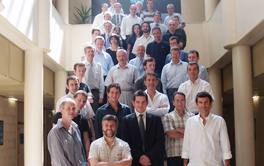INESC Porto hosts meetings of the NextGenPCF European project
The facilities of INESC Porto’s Optoelectronics and Electronic Systems Unit, located in Campo Alegre (Porto), hosted two meetings of the NextGenPCF ("Next Generation Photonic Crystal Fibre") European project, on 9, 10 and 11 July.
22nd July 2008
The first meeting took place on 8 July and it was called "General Meeting". The aim with this meeting was to allow all partners to make a situation report of the project’s first two years (the project will last three years) and to prepare the "Review Meeting". This second meeting took place on 9 and 10 July and it included participants, such as Markus Korn (the European person in charge of the project) and the technical experts, Valerio Pruneri and Bastiaan Verbeek.
Besides INESC Porto’s researchers, the meeting also welcomed partners from other institutions, such as Alcatel - Lucent (France), Altechna (Lithuania), Draka (France) Draka Comteq BV (Netherlands), FOS&S (Belgium), France Telecom (France), Heraeus Quarzglas (Germany), Horiba ABXDiagnostic (France), IPHT (Germany), Leukos (France), Multitel (France), NETCH (Italy), Osyris (France), Red-C Optical Networks (Israel), Unilim (France); University of Bath (UK) and USTL (France). Overall, the two meetings gathered approximately fifty researchers, managers and assessors.
During the meeting, INESC Porto presented and discussed the results obtained in the context of the "Sensor for environment" Work Package in which INESC Porto is directly involved together with FOS&S (Fibre Optic Sensors and Sensing Systems), IPHT (The Institute of Photonic Technology) and the University of Bath (United Kingdom).
There was also a “Demo session” that included the presentation of a functional prototype for a portable optoelectronic unit that remotely detects methane gas in residual concentrations. This presentation caused a strong impact on both partners and assessors.
Moreover, the consortium and the assessors analysed the possibility of including INESC Porto’s spin-off company – FiberSensing – in this project. The aim is to take the technology already developed to a more advanced level in commercial terms (transforming the prototype into a product), and optimise the future exploitation of the technology. This possibility was accepted and it is hoped that it will soon be made official.
BIP, July 2008


